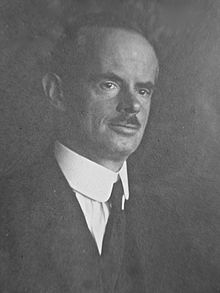Gustav Ammann
Gustav Ammann (born July 9, 1885 in Zurich ; † March 23, 1955 ) was a Swiss landscape architect who had a decisive influence on garden architecture in Switzerland in the first half of the 20th century , especially through numerous trend-setting publications.
Life
Ammann, who grew up in a middle-class family as the son of the President of the District Court on the Bürgli in Zurich-Enge, wanted to take up the gardening profession at an early age. However, after attending primary and secondary school, at the insistence of his parents in 1901, he first attended the cantonal commercial school, but dropped the federal commercial diploma in 1903 in favor of an apprenticeship as a gardener in the renowned gardening and landscaping company Froebel 's Erben, which he completed by 1905. He then worked at the Botanical Garden and at the same time attended lectures by its director, Hans Schinz, who was also professor of botany at the University of Zurich . In 1907 he left for Germany, where he initially worked in the garden architecture office of Reinhold Hoemann , a committed representative of the reform style . After working there for a year and a half, Ammann continued his training from 1908 at the Magdeburg School of Applied Arts and Crafts , where instead of the full course he took day courses - especially in drawing and representation - and met with fellow students from other areas across disciplines. From 1909 to 1911 worked for various offices, namely Franz Paetz in Düsseldorf and, after a short, unsuccessful stay in London, for Ludwig Lesser in Berlin and then for Jakob Ochs ' Hamburg company , where the later German gardening and social reformer Leberecht Migge was artistic director.
From 1911 until the company was dissolved in 1933, Ammann was the head garden architect at Otto Froebels Erben, where he trained the young architect Richard Neutra as an apprentice gardener and later the landscape architect Ernst Cramer . In 1934 Ammann founded his own office in Zurich and worked with leading modern architects in Switzerland, including Max Frisch and the CIAM architects Max Ernst Haefeli and Werner Max Moser . His most important projects include numerous “naturally” designed gardens and parks in the so-called modern residential garden style , which further developed elements of the German and English reform gardens from the turn of the century. Amman was the chief garden architect of the Zurich garden exhibition ZÜGA 1933 and the Swiss national exhibition Landi 1939. In numerous articles and in his book Blooming Gardens in 1955, he shaped the garden theoretical discourse of his time. Ammann's work was considered exemplary in the context of the European reconstruction after the Second World War. Ammann was, among other things, President of the Federation of Swiss Garden Designers (BSG) and Secretary General of the International Federation of Landscape Architects (IFLA) as well as a member of the Schweizerischer Werkbund .
Works
- Garden of the villa of the silk industrialists Bodmer and Hürlimann in Ottenbach in 1914
- Architectural garden at the Werkbund exhibition in 1917, Bern
- Neubühl housing estate , Zurich (1930–1932)
- Allenmoos outdoor pool , Zurich (1936–1939)
- Letzigraben outdoor pool (today Max-Frisch-Bad ), Zurich (1947–1949) in collaboration with Max Frisch
literature
- Yvonne Aellen et al .: Parks in Neu-Oerlikon: Oerliker Park, MFO Park, Louis-Häfliger-Park, Wahlenpark, Gustav-Ammann-Park. Green City of Zurich (Ed.), Zurich 2004.
- Gustav Ammann: Blooming Gardens. Erlenbach-Zurich 1955.
- Annemarie Bucher: From landscape garden to garden landscape: garden art between 1880 and 1980 in the archive for Swiss garden architecture and landscape planning. vdf Hochschulverlag AG, Zurich 1996.
- Luc Lienhard: Ammann, Gustav. In: Historical Lexicon of Switzerland .
- Johannes Stoffler: A blooming bathing landscape. In: Ulrich Binder, Pierre Geering (Ed.): Letzigraben outdoor pool. By Max Frisch and Gustav Ammann. Verlag Neue Zürcher Zeitung, Zurich 2007, ISBN 978-3-03823-378-7 .
- Johannes Stoffler: Gustav Ammann. Landscapes of Modernity. gta Verlag, Zurich 2008, ISBN 978-3-85676-194-3 .
- Udo Weilacher : visionary gardens. The modern landscapes by Ernst Cramer. Birkhäuser, Basel / Berlin / Boston 2001, ISBN 3764365684 .
Web links
- Publications by and about Gustav Ammann in the Helveticat catalog of the Swiss National Library
| personal data | |
|---|---|
| SURNAME | Ammann, Gustav |
| BRIEF DESCRIPTION | Swiss gardener and landscape architect |
| DATE OF BIRTH | July 9, 1885 |
| PLACE OF BIRTH | Zurich |
| DATE OF DEATH | March 23, 1955 |
| Place of death | Zurich |
